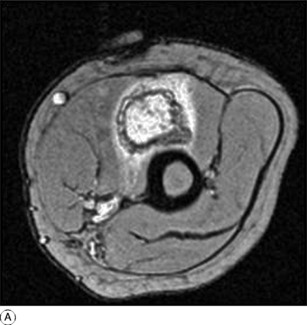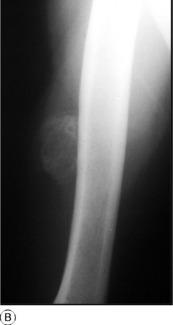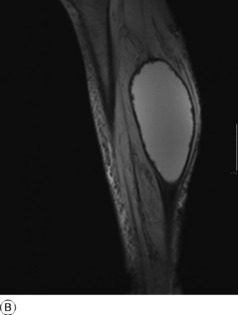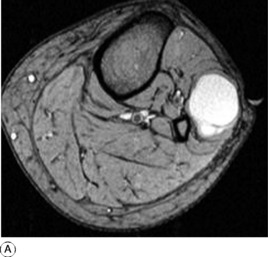10 Soft tissue tumours and other diseases
SWELLINGS AND TUMOURS OF SOFT TISSUE
Soft tissue swellings are a common presentation to primary care physicians and a cause of great anxiety to patients when they discover a lump in their limb or trunk which they interpret as a cancer. In fact malignant tumours are very rare and benign tumours are much more common in a ratio of more than 100:1. These tumours frequently cause problems in diagnosis and treatment because of the difficulty in differentiating them from other, much commoner, causes of lumps and swellings in the limbs. These include cysts and ganglia around joints, normal muscle variants, muscle rupture, haematoma, vascular aneurysm, and myositis ossificans.
Muscle tears
Symptomatic muscle tears are not usually a problem since there is typically a history of trauma and painful onset of swelling. Clinically there is therefore no suggestion that this is a soft tissue mass. However some patients, particularly in an older age group, present with a painless swelling with no clear history of any single incident to account for it. Characteristically this is seen in the anterior thigh. The reason is spontaneous rupture of rectus femoris muscle. The proximal muscle can contract unopposed with a resulting soft tissue mass palpable in the thigh. In cases of clinical doubt an MRI scan will confirm that the swelling is muscle and demonstrate the defect at the site of rupture (see Fig. 18.29, p. 414).
Haematoma
An acute tissue haematoma, whether from injury or post-surgery, should not pose a problem for clinical diagnosis. Difficulty can occur when a large deep haematoma does not resolve and enters a chronic phase that may mimic the swelling from a recurrent lesion. The MRI scan should aid diagnosis showing a peripheral dark rim from the presence of iron-containing haemoglobin breakdown products (Fig. 10.1).
Aneurysm
Occasionally an aneurysm originating from a deep vessel may mimic a soft tissue tumour, but careful clinical examination will normally identify arterial pulsation. Imaging with MR and digital arteriography can confirm the nature of the lesion and the vessel of origin.
Synovial cysts and ganglia
Ganglia are of unknown origin situated typically around joints and contain mucoid tissue. Trauma and synovial herniation are suggested as causative factors. They do not usually have a demonstrable connection with the underlying joint. They are seen most commonly around the wrist and ankle, but also occur near the knee arising from the proximal tibio fibular joint (Fig. 10.2).
Synovial cysts are a synovial lined outpouching which connects with the underlying joint space.
These therefore occur around joints most commonly and are typically seen especially in the knee. Popliteal (Baker’s) cysts (Fig. 18.32A, p. 418) and cysts associated with meniscal tears can present as palpable soft tissue masses. Ultrasound is the easiest method of confirming that these are cystic and not solid lesions.
Myositis ossificans (heterotopic ossification)
This is an uncommon but troublesome lesion because of its apparent malignant behaviour. It presents as a painful and tender lump in a limb muscle, with or without a history of recent trauma to the site. Imaging is crucial to obtain the correct diagnosis and MRI and ultrasound are the most useful in the very early stages as they can detect the presence of calcification in the lesion which is the key to diagnosis (Fig. 10.3A). Later imaging with CT scanning will reveal a diagnostic rim of ossification at the periphery of the well-circumscribed lesion. Plain radiographs after several weeks will show some calcification in the muscle which should indicate the correct diagnosis (Fig. 10.3B). However, in some patients where the early changes are not recognised these appearances may be misinterpreted and may lead to a presumed diagnosis of soft tissue osteosarcoma. This assumption may be reinforced if a biopsy is performed, as this will show a very active lesion containing immature mesenchymal cells with atypical nuclei and osteoid formation. No active treatment is required, other than careful observation, as the lesion will resolve in 2–3 months.


Fig. 10.3 A T2 weighted axial MR scan of the arm with myositis ossificans in the biceps muscle. Inside the mass of high signal there is a ring of low signal representing calcification. MR or ultrasound will detect calcification long before it is visible on plain films. B Radiograph of humerus in the same patient as Fig. 10.3A. This was obtained several weeks after the MR scan and the calcification within the muscle is now evident and a diagnosis of myositis ossificans is most likely.
TUMOURS OF SOFT TISSUE
BENIGN TUMOURS OF SOFT TISSUE
Benign peripheral nerve sheath tumours
Tumours arising from nerves are of two types: schwannomas and neurofibromas.
Schwannoma
These are just a little less common than neurofibromas. They are slow growing and painless with no neurological symptoms. They are typically less than 5 cm in size. The tumour usually lies eccentric to the nerve which is displaced. Surgical excision can thus be undertaken with sparing of the nerve.
Neurofibroma
Histologically the tumour is composed of cellular fibrous tissue arranged in whorls. The tumour may be solitary; but in the condition known as multiple neurofibromatosis (von Recklinghausen’s disease) (p. 70) numerous tumours are associated with pigmented areas in the skin. A neurofibroma growing within the spinal canal is an important cause of compression of the spinal cord or cauda equina.
Imaging with MR scanning can identify the nature of the lesion and sometimes its neural origin (Fig. 10.4).












